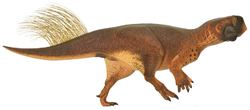| Gremlin Temporal range: Campanian, | |
|---|---|
 | |
| Restoration | |
| Scientific classification | |
| Kingdom: | Animalia |
| Phylum: | Chordata |
| Class: | Reptilia |
| Clade: | Dinosauria |
| Clade: | † Ornithischia |
| Clade: | † Ceratopsia |
| Clade: | † Euceratopsia |
| Family: | † Leptoceratopsidae |
| Genus: | † Gremlin Ryan et al., 2023 |
| Species: | †G. slobodorum |
| Binomial name | |
| †Gremlin slobodorum Ryan et al., 2023 | |
Gremlin (named after the mythical creature of the same name) is a genus of leptoceratopsid ceratopsian dinosaurs from the Campanian stage of the Cretaceous period, 77 million years ago. It contains one species, Gremlin slobodorum, named in 2023 by Michael J. Ryan and colleagues from a frontal bone found in the Oldman Formation of Alberta. It can be distinguished from other leptoceratopsids by a ridge on the frontal that runs transversely from the midline of the skull outwards to the top end of the orbit . [1]




